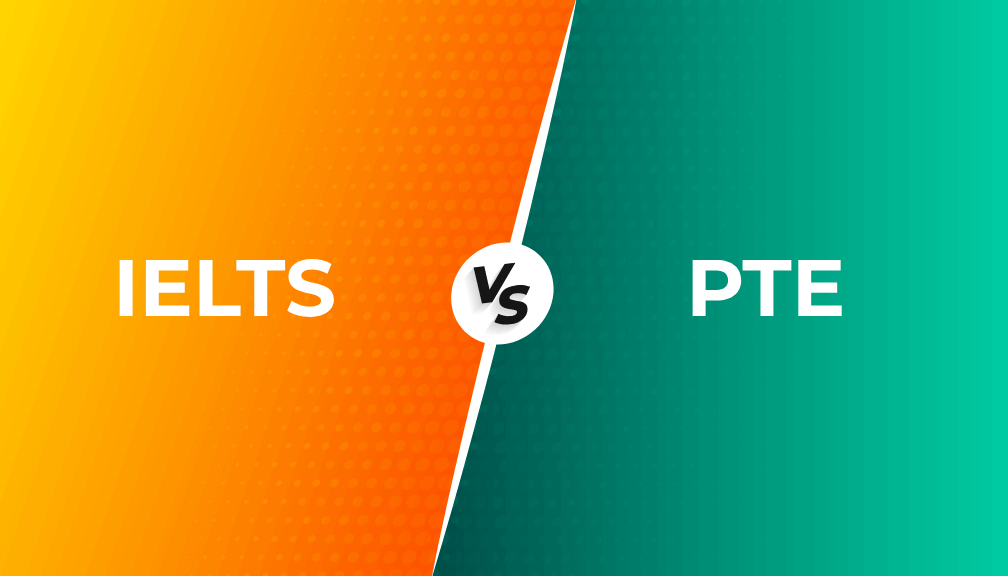IELTS vs PTE – Let’s say you have a new neighbour whom you invite for a small community get-together. You are hopeful to make new connections and friends by hosting the event.
After the event begins, you notice that your new neighbour is from a different place and doesn’t speak your language comfortably.
Would you be able to converse well with them even if you wanted to? As long as they don’t learn the language of the neighbourhood, they will not be able to have an actual conversation with anybody around.
However, someone who knows the language well, with all the slang and common phrases used in the community, makes a better connection with others.

It is already very new in foreign land, and trying to figure things out on your own without knowing the language will make it worse. This is the reason why Language proficiency is essential when you move to a new country.
The language proficiency test is an assessment that checks your ability to talk, understand, read and write in a particular language. Most tests check your language proficiency in English for obvious reasons.
These tests are generally taken when you want to move abroad for studies or to work long-term. There are many Language proficiency tests like IELTS, PTE, TOEFL, ACT, etc.. You can choose to take the one that meets the requirements for the purpose of your travel abroad. (like studies, job, visiting your family etc)
The most commonly accepted tests are IELTS, TOEFL and PTE. Let us now discuss the difference between IELTS and PTE.
You can check out our blog for the difference between IELTS and TOEFL.
An Overview
IELTS (International English Language Testing System) is a 2-hour and 45-minute long test administered jointly by the British Council, IDP Education and Cambridge Assessment English.
PTE (Pearson Test of English) is a shorter 2-hour test administered by Pearson VUE.
Both tests assess four categories of your English language proficiency- Reading, writing, Speaking and listening but in different patterns.
IELTS offers different test types for different purposes of the candidates (discussed further in the blog), while PTE is a standardised test irrespective of the purpose.
PTE is an entirely online test. You cannot take it in pen-and-paper mode. IELTS offers online and pen-and-paper modes for people who cannot access a proper internet connection.
Many institutions, immigration agencies, and companies accept these tests. However, make sure to check your institution or company’s requirements before taking the test.
IELTS has Three types of tests you can take based on your requirements.
- IELTS Academic: It has tasks suitable for candidates taking this test to pursue higher studies abroad and it tests the candidate’s proficiency in using the language professionally.
- IELTS General Training: This assessment focuses on contexts of a social gathering, workspace, etc., in testing your proficiency.
- IELTS Life Skills: This assessment tests the listening and speaking skills of candidates applying for a UK visa for the family or settlement route.
However, the most taken tests are IELTS Academic or IELTS General training; meanwhile, PTE is a simple language test to assess academic and professional proficiency.
Exam Pattern-Listening
IELTS
Four sections containing audio recordings of different contexts based on which 40 questions will be asked in total that are to be answered in 30 minutes. The sections include:
| Section 1 | A conversation between two people in the context of the common day-to-day conversation.
For Example: Conversation between a tenant and a landlord |
| Section 2 | A monologue in an everyday social context,
For Example: a speech by a guest at an Community gathering |
| Section 3 | A conversation among two to four people set in a training or an educational context,
for Example: a group project discussion at university |
| Section 4 | A monologue on an academic subject,
for Example: a Classroom lecture. |
PTE
You will be presented with eight sections of different questions where you’ll have to listen to the audio and answer the questions in 30-43 minutes. The questions are of the following patterns:
- Summarize the given audio
- Multiple choice questions
- Fill in the blanks
- Highlight the correct summary
- Find the missing word
- Find the wrong word
- Write from dictation
Exam Pattern -Reading
IELTS
Understand the verbal and inert meaning of the passages. Critically analyse the logic behind arguments and understand opinions and contexts. The duration of this test is 60 minutes.
IELTS Academic:
Three lengthy paragraphs intended for students preparing for undergraduate or post-graduate programs taken from journal articles, books, or magazines will be presented for you to read and answer the questions asked based on the paragraphs
IELTS General Training:
Excerpts from magazine articles, books or newspapers you come across in day-to-day life that is simple to comprehend, will be presented for you to refer while answering the questions asked based on them.
PTE
The pattern of this section is similar to that of IELTS, where you will be provided with a paragraph and written instruction based on which you have to answer the question asked. The questions are of the following patterns:
- Fill in the blanks
- Multiple choice questions
- Re-order paragraph.
The total time allocated for this section is 30 minutes.
Exam Pattern-Speaking and Writing
IELTS Speaking
This assessment section tests your ability to speak fluently irrespective of the context. Hence, the Pattern is identical for both IELTS academic and IELTS General Training.
You will be given 11 to 14 minutes to complete the section, a recorded assessment.
This section will consist of three parts as follows:
- In the first part, you will be asked to introduce yourself, and a few general questions will be asked about yourself, your work, your family, and anything that relates to you, just to see how you can converse with the examiner casually.
- In the second part, you will be asked to pick a random card with a particular topic. You will be given one minute to prepare for that topic and talk for two minutes. Finally, the examiner will ask 1-2 questions based on what you said in those 2 minutes.
- In the third part, the examiner will ask a few questions based on the topic you picked in the second part to discuss it in greater depth.
IELTS Writing
There will be two tasks, where you will be given topics related to graduate program studies or professional registration to complete during this session in a duration of 60 minutes
This assesses your ability to think rationally and present your ideas through these two essays- one short and one long.
IELTS Academic
Task 1: A graph, chart or diagram will be presented to you, and you have to explain, summarise, and draw inferences using your own words. You will be asked to describe a particular process, event, or how an object works in a formal style.
Task 2: You will be asked to write an essay in a formal style regarding an argument, opinion or point of view.
IELTS General Training
Task 1: You will be given a situation using which you have to write a formal or semi-formal letter seeking or explaining a piece of information.
Task 2: You will be asked to write a semi-formal or a quite personal essay on an argument, opinion or point of view
PTE Speaking and Writing
Unlike in IELTS, PTE has a combined assessment for speaking and writing for a duration of 54 to 67 minutes. This section assesses your speed of expression through verbal and written communication by providing you a written text that you will be reading for the first time.
This will include five types of questions, namely:
- Describing an image
- Retelling the lecture
- Answering short
- Summarizing the written text
- Essay writing
Though all the Language proficiency tests analyse your proficiency, there are pros and cons to every test.
There are no good or bad language proficiency tests. Weigh the pros and cons that serve you the best. Research on the requirements of your institution and choose the right Language proficiency test.




